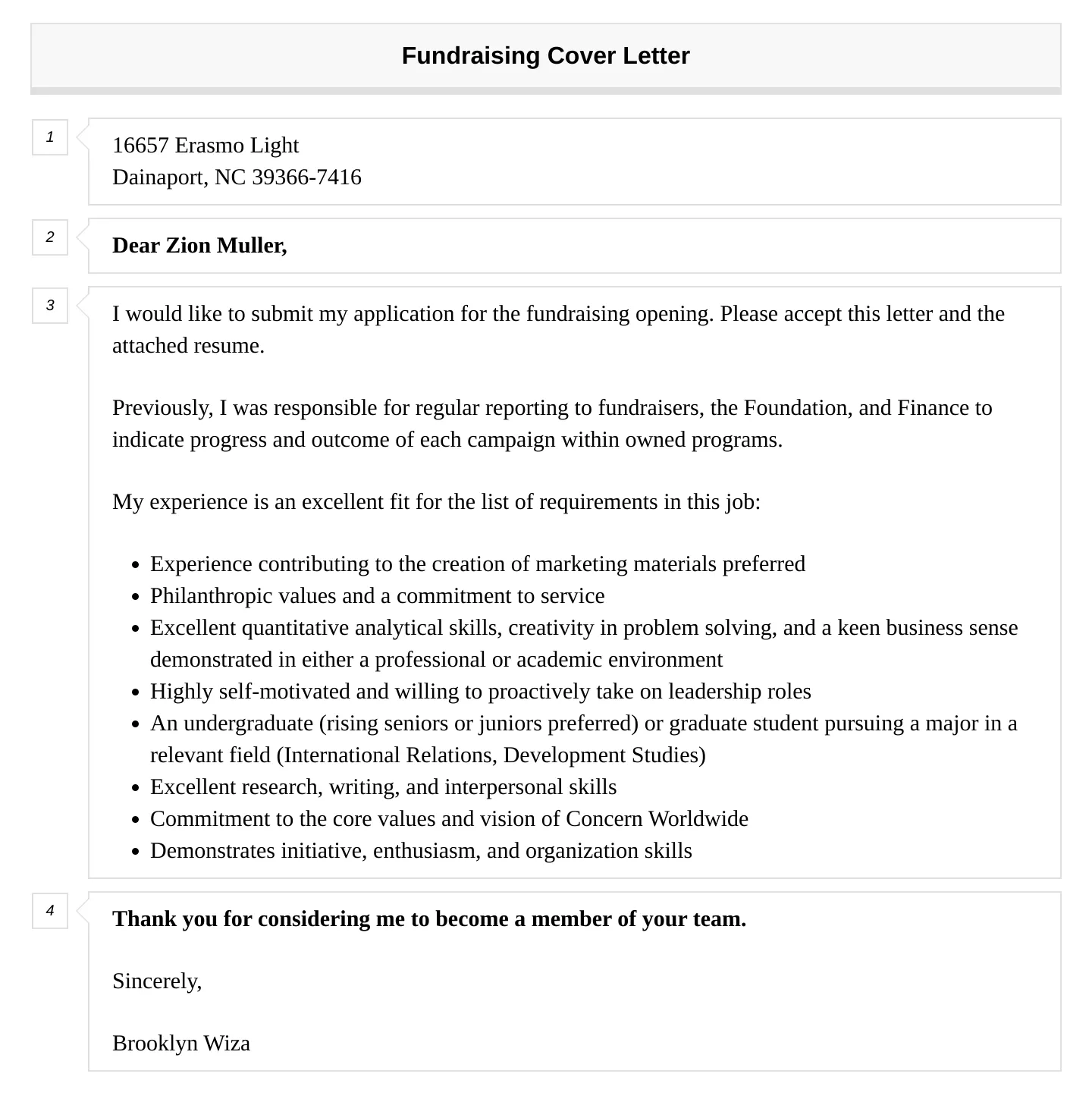What Is a Cover Letter Fundraising Job?
A cover letter for a fundraising job is a crucial document that accompanies your resume when you apply for a position in the fundraising or development sector. It serves as a personalized introduction, allowing you to highlight your relevant skills, experience, and passion for the role. Unlike a resume, which provides a factual overview of your background, a cover letter enables you to tell a story, showcasing how your qualifications align with the specific requirements and objectives of the organization. This letter is your opportunity to make a strong first impression, demonstrate your understanding of the organization’s mission, and express your enthusiasm for the opportunity.
Why You Need a Cover Letter for Fundraising Jobs
In the competitive field of fundraising, a well-crafted cover letter is essential for several reasons. First, it allows you to differentiate yourself from other applicants by providing a more in-depth look at your qualifications and personality. Second, it demonstrates your genuine interest in the organization and its cause, which is particularly important in the nonprofit sector. Third, a cover letter allows you to address specific job requirements and explain how your skills and experiences align with the role’s responsibilities. By customizing your cover letter for each application, you significantly increase your chances of getting noticed by the hiring manager and securing an interview. Ignoring this important step could lead to your application being overlooked.
Key Components of a Cover Letter Fundraising Job
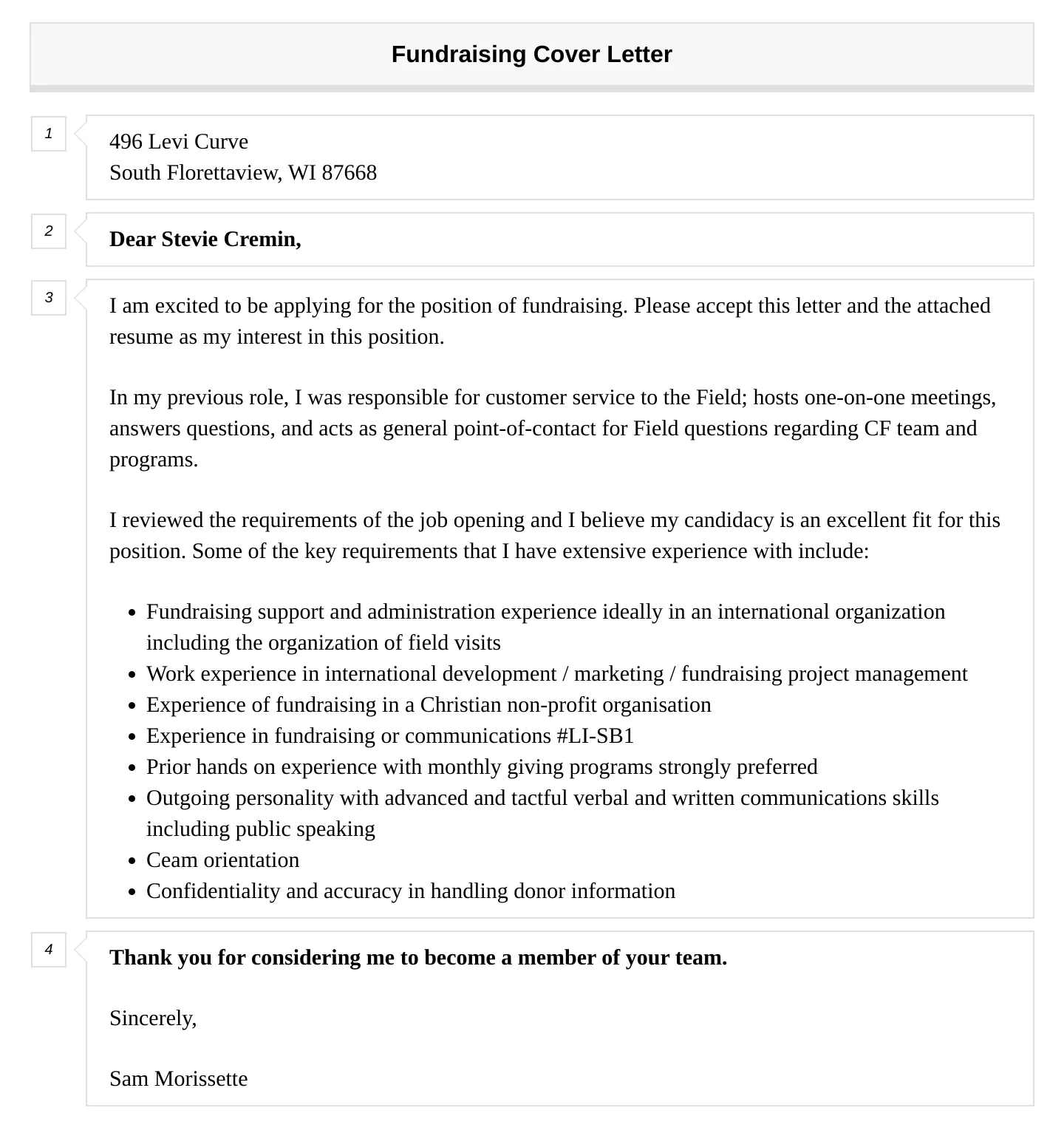
A successful cover letter for a fundraising job includes several key components, each of which plays a vital role in showcasing your suitability for the position. These components work together to create a compelling narrative that highlights your qualifications and passion for fundraising. Remember to tailor each component to the specific job description and the organization’s mission. Missing any of these key components may make it harder to get the role. Focusing on these aspects will make your application stand out.
Contact Information and Salutation
Begin your cover letter with your contact information, including your name, address, phone number, and email address. This ensures the hiring manager can easily reach you. Following this, address the letter to the specific hiring manager if possible. Research the organization to find the correct person’s name and title. If you cannot find a specific name, use a professional salutation such as “Dear Hiring Manager” or “Dear [Department Name] Team.” Avoiding generic salutations like “To Whom It May Concern” shows you’ve done your research and are genuinely interested in the opportunity.
Writing an Engaging Opening Paragraph
Your opening paragraph is your first chance to grab the reader’s attention. Start with a strong statement that immediately captures the hiring manager’s interest. Briefly mention the position you are applying for and where you found the job posting. Then, state your passion for fundraising and the organization’s mission. Consider including a brief, compelling anecdote or a standout achievement to make a lasting impression. The goal is to make the reader want to learn more about you and your qualifications. Make it personalized, showing your knowledge and interest in their work.
Highlighting Your Fundraising Experience
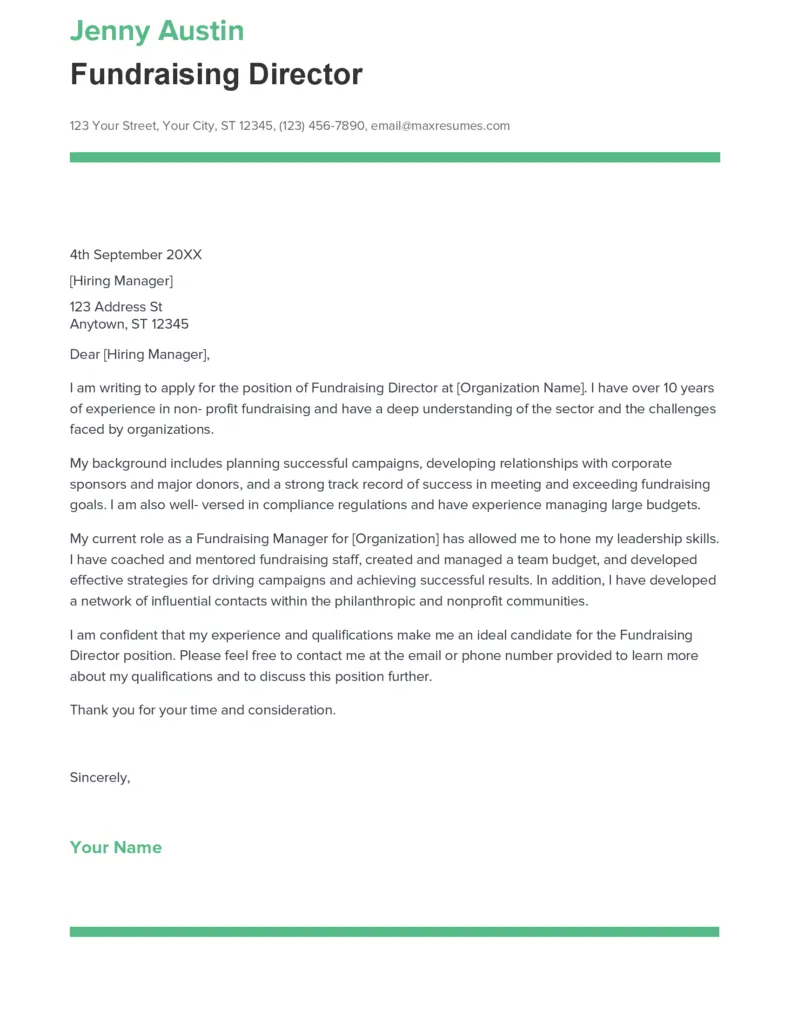
The core of your cover letter should focus on your relevant fundraising experience. Describe your past roles and responsibilities, emphasizing those that align with the job description. Highlight specific skills, such as grant writing, donor relations, event planning, or digital fundraising. Provide concrete examples of your achievements, using the STAR method (Situation, Task, Action, Result) to illustrate your contributions. Focus on the skills and experiences that are most relevant to the position you are applying for. This will help the hiring manager quickly understand your capabilities and how you can contribute to their team. Avoid just listing responsibilities; focus on what you achieved.
Quantifying Achievements and Results
Whenever possible, quantify your achievements with specific numbers and data. Instead of saying “Increased donations,” say “Increased donations by 20% in one year.” Use metrics to demonstrate the impact of your work, such as the number of donors acquired, the amount of funds raised, or the success of fundraising events. Providing concrete results helps the hiring manager assess your capabilities and understand the value you can bring to the organization. Be specific and use data to support your claims, as this adds credibility to your application and showcases your ability to deliver tangible outcomes.
Demonstrating Passion for Fundraising
Fundraising is often driven by passion and a commitment to a cause. Show your genuine enthusiasm for the organization’s mission and the impact it makes. Explain why you are drawn to the specific cause and how your values align with the organization’s work. Share your personal connection to the cause, if applicable. This demonstrates your long-term commitment and enhances your credibility as a candidate. Highlight your knowledge of the organization’s programs and initiatives, which shows you’ve invested time in learning more about the work and the impact they make.
Showcasing Relevant Skills and Qualities
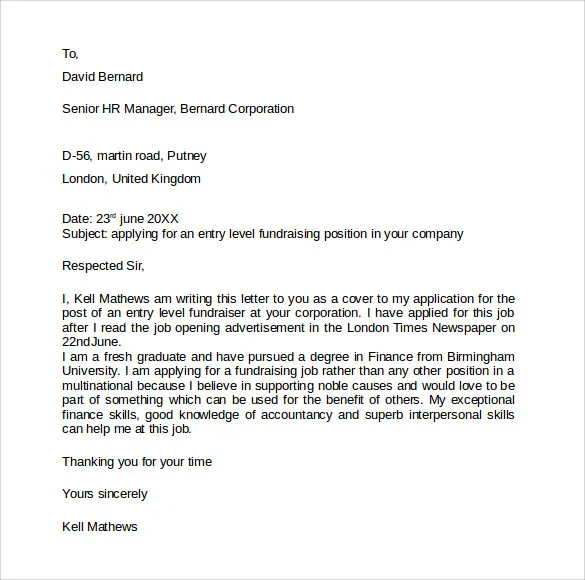
Identify and highlight the skills and qualities that are most relevant to the fundraising job. These might include communication, relationship building, leadership, organizational skills, and grant writing expertise. Provide examples of how you have utilized these skills in past roles. Mention any relevant software or tools you are proficient in, such as CRM systems or fundraising platforms. Tailor your skills section to the job requirements. Showing how your skills meet the needs of the role can make your application stronger. Be sure to provide specific examples to illustrate your skills.
Tailoring the Cover Letter to the Job Description
Customize your cover letter for each job application by carefully reviewing the job description. Identify the key requirements, skills, and experiences the employer is seeking. Then, structure your cover letter to address these specific aspects. Use keywords and phrases from the job description to show that you understand the role and are a good fit. This demonstrates that you have taken the time to understand the organization’s needs. This will make your application more relevant and increase your chances of being selected for an interview.
Including a Strong Call to Action
Conclude your cover letter with a strong call to action. Express your enthusiasm for the opportunity and reiterate your interest in the position. State your availability for an interview and provide your contact information again. Thank the hiring manager for their time and consideration. By including a clear call to action, you encourage the hiring manager to take the next step and schedule an interview. End your letter professionally and with a positive tone to leave a lasting impression.
Proofreading and Editing Your Cover Letter
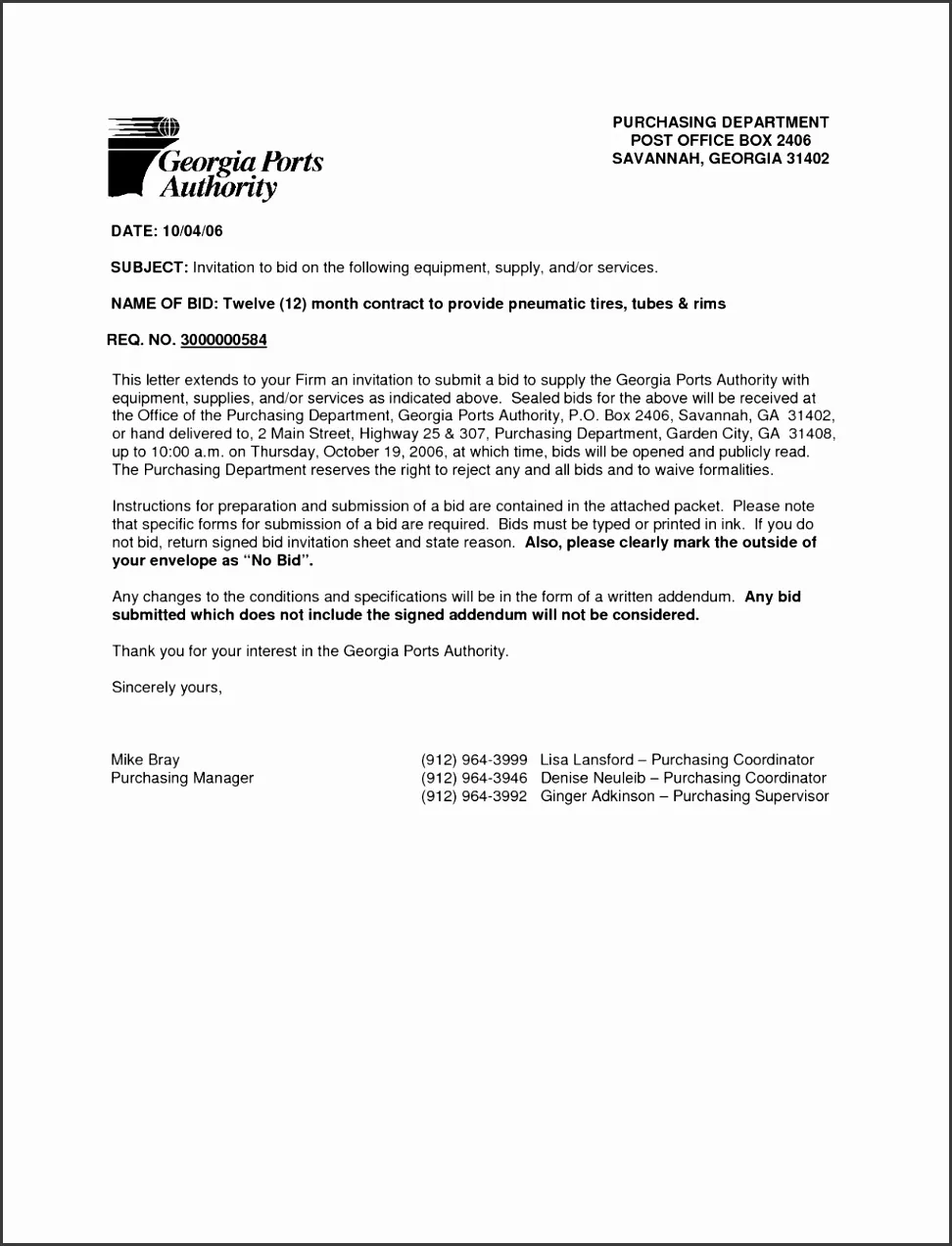
Before submitting your cover letter, carefully proofread and edit it to ensure there are no errors in grammar, spelling, or punctuation. A polished cover letter reflects professionalism and attention to detail. Have someone else review your letter to catch any mistakes you may have missed. Ensure that the format is consistent and easy to read. This step demonstrates that you take pride in your work. Taking these extra steps ensures that your application makes a positive impression.
The Importance of a Professional Closing
End your cover letter with a professional closing, such as “Sincerely,” “Best regards,” or “Thank you for your consideration.” Avoid casual or informal closings. Include your typed name below the closing. This creates a professional and respectful tone. A well-crafted closing reinforces your professionalism and leaves a positive impression. This final detail can make a significant difference in how the hiring manager perceives your application. Ensure this section is formatted correctly and matches the tone of the rest of the letter.
